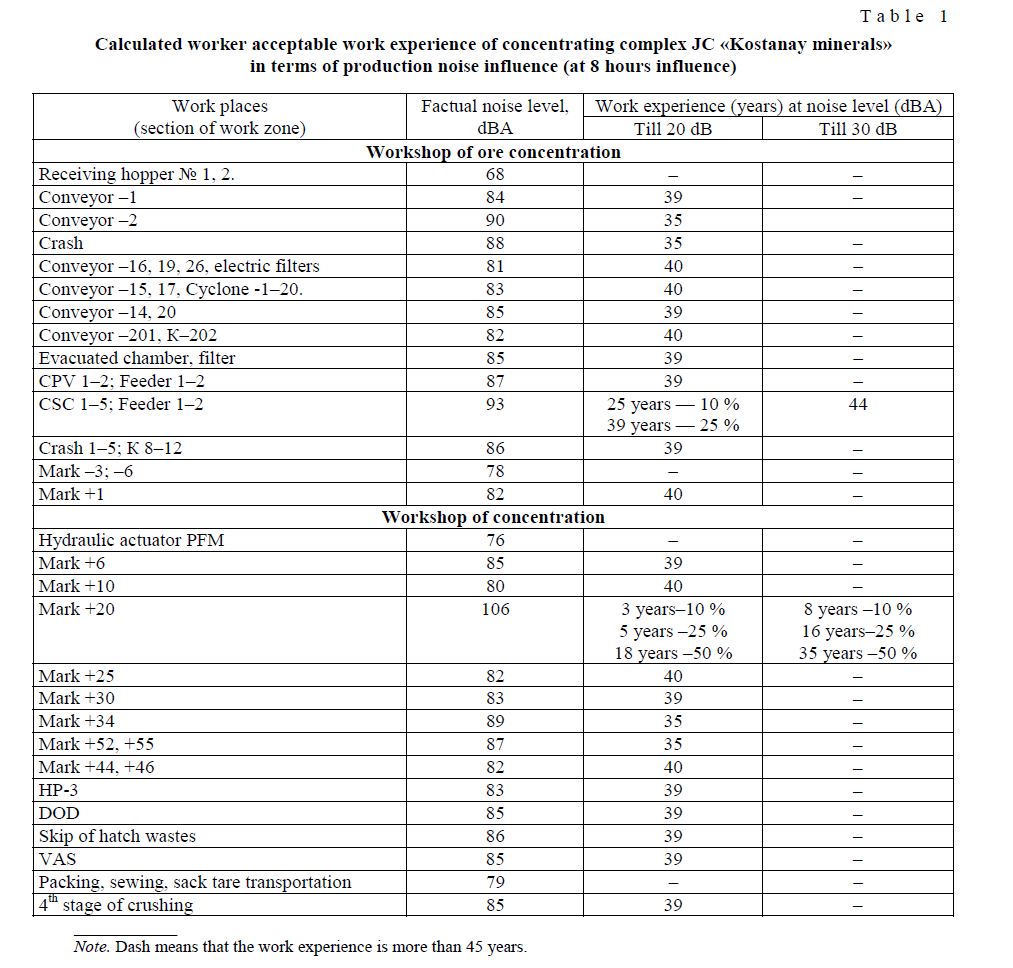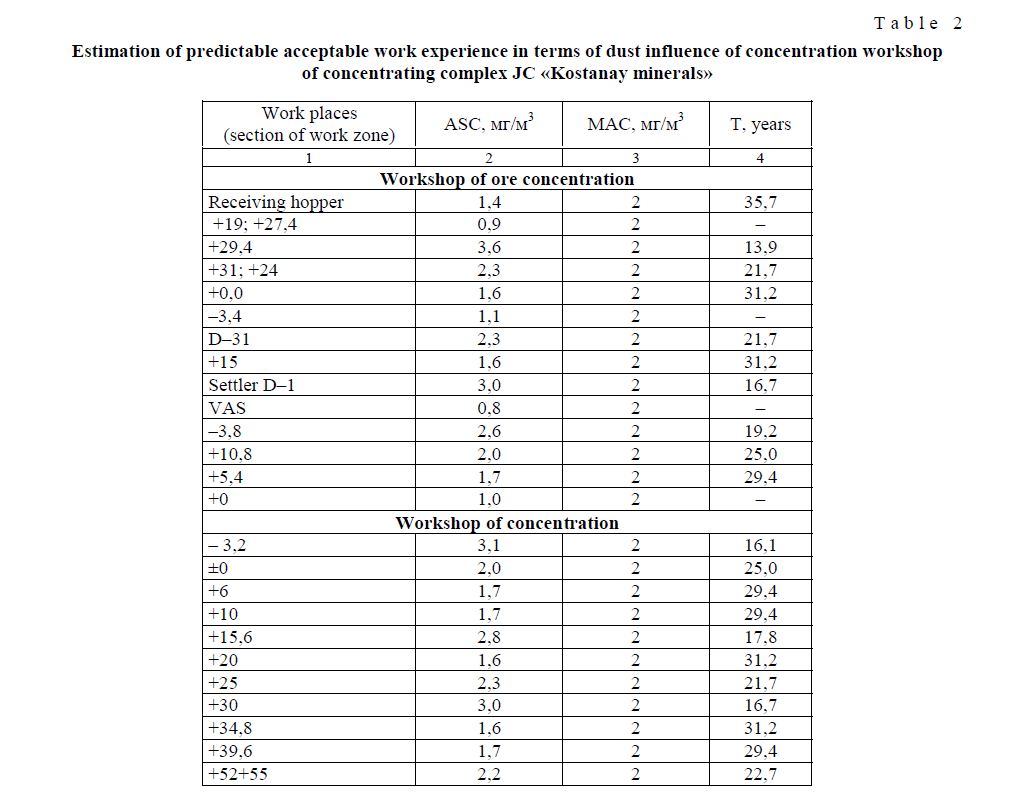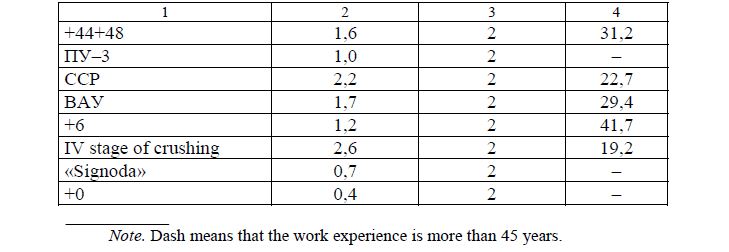The problem of safety with the use of asbestos in last years is paid intent attention of specialists and departments, which are responsible for population health protection. Many international organizations and WHO, ILO, IARC first of all pay attention to this problem [1, 2].
The problem of asbestos established lungs diseases till present time stays enough actual, through this question was devoted many number of researches [3–5].
The noise accompanies human with first day of his life and is one of most widespread hostilities of production and natural environment. Long influence of noise is increased than hygienic norms, lead to professional diseases development of acoustic organ — double-sized sensorineural deafness. The human with lower hearing significantly most difficult adapts in society, is restricted in choice of education and professional activity, faces with specific difficulties in interpersonal society not only in family, but and I labor staff. This is one of basic reasons (besides fear of working place lost as a result of professional diseases and slower lower hearing subjective sensation development) unwillingness of timely visit for medical aid in the process of hearing disorder, that in turn lead to incomplete an later detection of sensory deafness of professional etiology [6].
Professional contact is possible with natural and artificial inorganic fibres consisting of industrial dust, also and for account of special material extensive use and it contain in many branches at the present time. Practically all kinds of industrial inorganic fibres in that or other degree can render the negative influence on human health. Most widespread usage had six kinds of natural inorganic fibres, which are combined under commercial name «asbestos». It is five fibres of amphibolic group and one mineral of serpentine group (chrysotile) [7].
Full exclusion of production environment of hostilities is impossible in connection with technologic, economic and other difficulties. Therefore principle of level and time limitation of hostilities influence is implementating in practice, i.e. «protection by time». The term «protection by time» means the deleterious effect decrease of working environment and labor process hostilities on workers [8, 9]. Calculation of acceptable work experience is conducted in unfavorable conditions of production environment for estimation of work continuousness possibilities in hygienic researches. The calculation of acceptable experience permits to definite the preventive arranges which direct to the decrease of harmful industrial factors influence on worker organism.
Purpose of work is a calculation of acceptable work experience in conditions of noise and dustiness influence for workers of chrysotile asbestos industry.
Research materials and methods. Objects of research are leading professions, which work on industrial subdivisions of mining enterprise JC «Kostanay minerals». Research of acoustic atmosphere and dustiness level was conducted on work places of basic professions of concentration workshops and ore concentration of concentrating complex.
Noise measurement was conducted on work places in typical conditions of equipment exploitation. The purpose of these measurements is hygienic noise estimation as harmful factor of production environment and definition of calculated safe work experience.
Acoustic apparatus of firm «SVAN» was used for measurement of noise parameters. Measurement and estimation of noise parameters conducted according to requirements of sanitary norms and rules № 139
«Hygienic normative of noise level on work place». Also general noise level on scale dBA registered and identified their intensity on frequencies from 31,5 till 8000 Hz.
Identification of acceptable (safe) work experience in terms of noise influence was identified according to Standard ISO — 1999.2 «Acoustics. Identification of professional noise level influence and hearing disorder estimation is provoked by noise». Standard is devoted to estimated probability questions of specific hearing disorder in depend on exposition and permits to prognosis the probability of professional diseases origin and estimates effectiveness of prophylactic measures [10].
Information about average shift concentration (ASC) of dust in work place air, which presented by laboratory staff of JC «Kostanay minerals» were used in the base of calculations of acceptable (safe) work experience in conditions of dustiness for professions of concentration workshops and ore concentration of concentrating complex on work places.
On the basis of measurement protocols ASC of dust, we calculated and identified acceptable (safe) work experience in professions of concentrating complex.
Research results. Basic risk factors of worker’s professional sensory deafness development of basic professions of ore concentration workshop (ore accepter, driver of crushing and grinding sorting machine, driver of ventilation and aspiratory installations, operator) and concentration workshop (driver of crushing and grinding sorting machine, traffic-controller, and crusher-operator) are intensive noise. It is known that production noise causes on hearing disorder function development, as well as influence on all organism and promotes to the development of untimely fatigue which leads to attention concentration decrease, labor capacity and exactness of worker functional duties execution of dangerous noise professions.
We calculated the noise doses, which the workers got during work time period, on base of chronometric researches of worker labor activity of concentrating complex in the process of work with technological equipments. That is, noise dose is an integrated quantity, taking into account the acoustic energy, which influence on human organism during definite work time period.
Considering that hearing loss of I degree with big possibility can develop and without noise influence in the result of age changes, presents the unreasonable to use I degree of hearing impairment for safe work experience estimation. In connection with it in table № 1 presents computed values of work experience during f which can develop the hearing disorder of II and III degree in depend on noise level I work places.
Technological equipment concentration in workshops and plots in the process of professional activity leads to noise influence on work places of leading professions, which are worked by crushing and concentration of chrysotile-asbestos ore.
Research results showed that the noise level on work places of or concentration workshop is 68–93 dBA, at acceptable norms 80 dBA. As we can see from Table № 1, we calculated and identified parameters of safe work experience on work places of ore concentration workshop with such noise level from 40 till 35 years old.
According to our researches, the highest noise level was registered in work zone CSC 1–5 (conical secondary crushing). It general level was 93 dBA and exceeded a maximum permissible level on 13 dBA. The calculation indicator (criteria till 20dB) of acceptable work experience of 10 % of workers is 25 years old, but 25 % of workers — 39 years old. The probability of hearing loss on level of criteria meaning till 30dB is 44 years old of work experience.
According to the presented table (table 1), most level of acoustic energy in concentration workshop noticed on section by mark + 20. The measurement of noise level on mark +20 showed the excess of normative sizes on 26 dBA at the rate of 80 dBA.
Analysis results of noise level on work places f concentrating workshop showed that the excess of normative values observes on all sections of work zone, besides work places on sections of pile-forming machine hydraulic actuator (PFM), work places of packing, sewing, sack tare transportation and on mark + 10. The levels of noise are especially high on sections of work places with marks +6, +34, 52 and 55, in the dry ore depot (DOD), skip of hatch wastes and in 4 stages of crushing and exceeds acceptable sizes from 5 till 9 dBA.
Research of noise level is presented in Table 1 to show, that level of acoustic vibrations on sections with mark +25, +30, +44; +46 and hoisting plant (HP 3) exceed the normative values on 2–3 dBA. The results of conducted calculation of acceptable work experience on work places PFM and packing, sewing, sack tare transportation and on mark + 10 (table 1) show that acceptable work experience on these work places is more than 45 years, t.i. noise level is found with the scope of sanitary norms requirements.
T a b l e 1
Calculated worker acceptable work experience of concentrating complex JC «Kostanay minerals» in terms of production noise influence (at 8 hours influence)

Note. Dash means that the work experience is more than 45 years.
By factual noise level (80–82 dBA) the calculated acceptable experience on work places (mark +10; +25 and +44, 46) is 40 years of work experience, that is on level of criteria till 20 dB. On the scope of same criteria — till 20 dB the safe work experience on level of 39 years was calculated for professions in work zone «Mark» + 39; HP-3, DOD, skip of hatch wastes, ventilative and aspiratory section (VAS) and 4th stage of crushing. But marks +34 и +52, +55 on sections are the acceptable work experience — 35 years. The origin of hearing loss reasons on mark +20 from 10 % possibility from influence of industrial noise is on the scope of 3 years; with 25 % possibility of professional pathology development of respiratory organs observes in 5 years. The half of basic separators professions, risk of professional hearing loss development with probability 50 % can develop through 18 years.
Received information permits to prognosis the possibility of specific hearing disorders on level of criteria till 30dB of workers on section with mark +20. Representatives of basic professions, who work on mark + 20 have the hearing function disorder, 10 % could get the development of hearing disorder only after 8 years, and 25 % and 50 % of workers — through 16 and 35 years of work experience.
Thereby, generalized results of hygienic probability estimation of professional hearing loss development under the influence of noise, we can to prognosis, that hearing function loss with big probability from influence of industrial noise in ore concentration workshop of concentrating complex is 25–44 yeas of work experience. Hearing lower with big probability (contact with noise must be during 8 hour working shift) can develop by 10 % and 25 % of basic professions workers through 3 and 5 years of work experience. 50 % of workers who works on mark + 20, hearing loss development till 20 dB could observe through 18 years of work. The hearing loss of 3rd level (till 30 dB) for workers of mark +20 with big probability can develop through 8 and 16 years of 10 % and 25 % of workers. The half (50 %) of workers has the probability of hearing function loss through 35 years.
T a b l e 2
Estimation of predictable acceptable work experience in terms of dust influence of concentration workshop of concentrating complex JC «Kostanay minerals»


Note. Dash means that the work experience is more than 45 years.
The usage of highly mechanized equipment with one side significantly makes the worker labor easier, with other side — all process of ore concentration is accompanied by significant dust discharge.
High dust concentrations notice at the transportation, crushing and sifting of ore concentration.
The elaboration of acceptable wok experience permits to prognosis the probability of professional diseases origin and estimates the effectiveness of prophylactic measures.
Results of predictable lungs pathology development from of chrysotile-asbestos dust influence in workshops of ore concentration and concentration of concentrating complex are presented in the Table 2.
Following values for work experience were got in the process of risk estimation of dust pathology development on work places in the ore concentration workshop in the contact with dust, whereby predicts development of professional disease from observed sections of work zone: more than 45 years of work on sections of ore concentration workshop +19; 27,4; –3,4; VAS; + 0 mark. In this workshop for work zone of receiving hopper, marks 0; +15; +10,8; 5,4 predictable period of respiratory tracts pathology development composed 35, 7–25 years of work, at average shift concentration 1,4–2 мг/м3. By average shift of dust concentration on level 2,3–3,6 мг/м3 the predictable work experience duration whereby can develop professional disease is 21,7–13,9 years of work experience.
Conducted hygienic researches in concentration workshop showed that industrial environment at concentrations of chrysotile-asbestos ores is not enough optimally. So, average shift concentration of chrysotileasbestos dust on sections — 3,2; +15,6; +25; +30; +52, +55 и ІV stage of crushing is found in the scope of 3,1–2,2 mg/m3, if the norm is 2 mg/m3. Conducted calculation of acceptable work experience on these marks showed that predictable safe work experience duration under influence of chrysotile-asbestos dust is found in the scope of 16,1–22,7 years of work experience.
The conducted analysis for periods of lungs pathology formation from influence of chrysotile-asbestos dust permits to separate sections (mark ±0; +6; +10; +20; +34,8; +39,6; +44 and +48; VAS and +6) where periods of professional diseases development is from 25 till 41,7 years of work experience. The level of average daily concentration is from 2 mg/m3 till 1,2 mg/m3 on these sections. The content of average shift dust concentration from 1 till 0,4 mg/m3 on work places of sections HP-3, PFM «Signoda» and mark +0 didn’t exceed normative values. Received information permits to propose, that these numbers of average shift concentration is that concentration, for which, as a rule, doesn’t happen the formation of professional pathology.
Therefore, analysis of lung pathology formation periods from influence of chrysotile-asbestos dust permits to detect that safe work experience in ore concentration workshop on different marks is for appropriate professions in the scope of 13,9–35,7 years of work experience. The predictable safe work experience is more than 45 years on marks +19; –3,4; +0 and VAS, i.e. the level of average shift concentration doesn’t exceed the acceptable dustiness levels.
The predictable safe work experience is more than 45 years of work experience at the rate of ASC 1–0,4 mg/m3 on production sections HP-3, PFM «Signoda» and on mark +0 of concentration workshop.
Conclusions
- Hearing loss with big probability from industrial noises influence in ore concentration workshop happens at the work experience from 25–44
- Hearing loss with big probability for workers on marks + 20 (contact with noise must be during 8 hour working shift) can develop by 10 % and 25 % of basic professions workers through 3 and 5 years of work 50 % of workers who works on mark + 20, hearing loss development till 20 dB could observe through 18 years of work. The hearing loss of 3rd level (till 30 dB) for workers of mark +20 with big probability can develop through 8 and 16 years of 10 % and 25 % of workers. The half (50 %) of workers has the probability of hearing function loss through 35 years.
- Safe work experience in ore concentration workshop on different marks is for appropriate professions in the scope of 13,9–35,7 years of work The predictable safe work experience is more than 45 years on marks +19; –3,4; +0 and VAS, i.e. the level of average shift concentration doesn’t exceed the acceptable dustiness levels.
- The predictable safe work experience is more than 45 years of work experience at the rate of ASC 1–0,4 mg/m3 on production sections HP-3, PFM «Signoda» and on mark +0 of concentration
References
- Izmerov N.F. Elaboration of national program on asbestos established diseases elimination // Labor medicine and industrial — 2011. — № 5. — P. 1–16.
- Izmerov F., Kovalevskiy E.V. Basics of national program elaboration on asbestos established diseases elimination // Labor medicine: Realization of Global action plan on health of workers for 2008–2017: Mater. All-Russia conference — Moscow, 2008. — P. 116–118.
- Pluhin A.E., Burmistrova T.B., Postnikova L.V. Modernization of prophylactics and rehabilitation system principles of asbestos established diseases of bronchopulmonary worker system // Labor medicine and industrial ecology. — 2011. — № 5. — P. 37– 44.
- Kosyachenko E., Suvorova I.V., Tishkevich G.I. Hygienic aspects of asbestos circulation and worker labor terms of asbestos processing organizations of Belorussia // Profession and health: Mater. All-Russia Congress — Moscow, 2011. — P. 249–251.
- Salnikova N.A., Demetskay A.V., Moshkovskiy V.E. Chrysotile-asbestos dust control in air of work zone: Ukraine Experience // Profession and health: Mater. All-Russia Congress — Moscow, 2011. — P. 438–439.
- Ilkaeva N. Professional deafness — psychosocial side of problem // Profession and health: Mater. All-Russia congress — Moscow, 2010. — P. 221–223.
- Kovalevskiy V., Kashanskiy S.V. Correction of maximum permissible dust concentration in the air of work zone, which contain natural and artificial inorganic fibres // Profession and health: Mater. All-Russia congress — Moscow, 2011. — P. 229– 231.
- Ibraev A., Zhusupov K.K. et al. Prognostication of professional deafness under influence of production noise of chrysotileasbestos production workers // Modern technologies in labor medicine: Mater. International scientific conference — Donetsk, 2009. — P. 52–54.
- Ibraev S.A., Zhusupov K.K. et al. Calculation of acceptable work experience I the contact with chrysotile contain dust in professions of mining and transport enterprise // Ural medical journal. — 2008. — № 11. — P. 32–34.
- Izmerov N.F., Suvorov G.A. Physical factors of production and natural environment. Hygienic estimation and control. — Moscow: Medicine, 2003. — 555